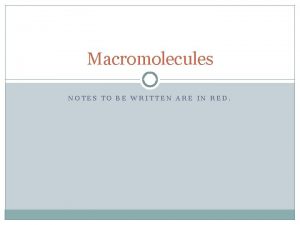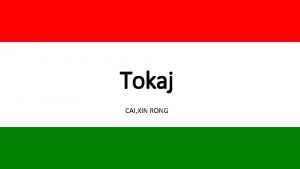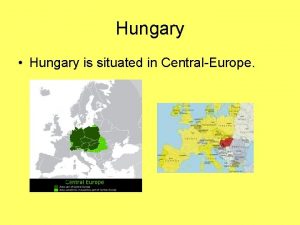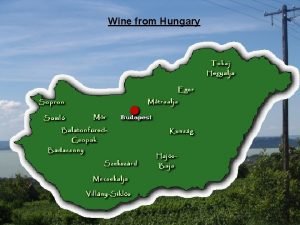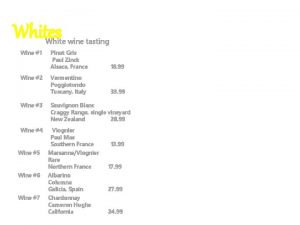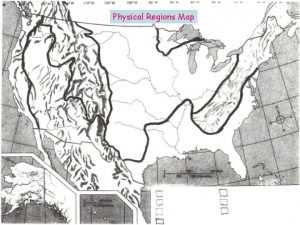Hungary 22 Wine Regions 8 more prominent Tokaj


















- Slides: 18

Hungary • 22 Wine Regions • 8 more prominent • • Tokaj Kunság Csongrád Hajós-Baja Eger Villány Szekszárd • Tokaj, in northeast Hungary, at the foot of the Carpathian Mountains is best known for its sweet Tokaji Aszú wines, as well as the Furmint, Hárslevelű and Muscat grapes

Slovakia River Danube Austria Great Plains Romania Slovenia Lake Balaton Croatia

Hungary. The Romans brought the first grapevines to Hungary and by the fifth century there were extensive vineyards. In 2010, Hungary accounted for nearly 1. 5 percent of the world’s wine production and the quality is rapidly improving since the Communists left. As wine quality came to matter more, and accumulating stocks of wine needed more space, real cellars carved in tuff by well-heeled merchants and peasants began to supersede vaulted cellars and the plainly modified natural cavities in darázskó (“honeycomb rock”, an old Hungarian name for volcanic tuff) that had also served as wine stores till then. According to wine production statistics for 2010, Hungary was the 16 th largest producer of wine in the world with more than 334 million liters. They ranked ahead of Brazil, Austria, Ukraine and New Zealand. During the Communist occupation of Hungary, most of the wines were produced in cooperatives and the quality suffered. Phylloxera struck Hungray in the 1870’s devastating the southern vineyards. After replanting with phylloxera-resistant, stocks began to flourish in 1881 In recent years, small wineries have flourished, vineyards have been replanted and new grape varieties have been introduced.

Region and terroir • Hungary lies between 45 and 50⁰ • Land-locked but includes Europe’s largest lake, Balaton. The river Danube flows through it from north to south, dividing the country in almost equal halves. • Climate is continental and central European; fairly predictably cold winters and hot summers • Northerly latitude on par with Burgundy makes it ideally situated to produce aromatic and semi-aromatic varieties • Soils are varied; The Great Plain is mainly sand loess (a light colored, fine-grained accumulation of clay and silt particles. Calcerous silt deposited by the wind), the area around lake Balaton is a mixture of volcanic rock with clay and sandstone. Other areas are limestone and slate. The best wines often come from volcanic soils, producing full structured wines with minerality

Eger Region • Area: 3910 hectares. • Vine varieties, wines: Kékfrankos, Cabernet, Merlot, Kékoportó are the base of Egri Bikavér. Characteristics of the wine: harmonious, fullbodied, velvety, harsh, warming, – it gets its characteristic bouquet after years of ageing in wooden casks. From grapes named Leányka is made the slightly sweet, fruity wine with complex taste-harmony. Italian Riesling – harmonious, fine, characteristic fragrance, elegant acidic. Tramini – characteristic fragrance and bouquet.

Eger • Eger reds are typically medium-bodied but reasonably tannic and dark, although in cooler vintage years they tend to lose both color and tannin, and can be on the harsh side. In terms of body, tannin and alcohol, the regional average rarely achieves the standards of Hungary’s southern red wine regions. Their elegance and complex harmony of taste give them a respectable position among Hungary s red wines. • Traditionally, Eger’s best red was of course the aforementioned Bikavér (“Bull’s Blood”), originally a fiery blend of Nagyburgundi (Kékfrankos), Kékoportó, and Kadarka. The brand was properly established by a man named Jenő Grőber, who borrowed the memorable name from Szekszárd and also perfected the recipe of the blend by adding Medoc Noir for body.

Hungary • Eger, in the north of the country produces elegant reds, in particular the Bikavér blends. If you wish to try the best of the Bull's Blood variety, look for the Bikavér Superior label, established by recent wine laws. Due to the latitude, wines from the Eger region do not have the body of reds from the south, but they are elegant and complex in a way that allows for a comparison to Burgundy. They have a yearly Egri Bikavér Festival (traditionally held in July) where a huge number of local wineries offer their take on the Bull's Blood, accompanied by some hearty bites and folksy tunes.

‘Bulls Blood’ • The name of the wine originates from an event that happened in Eger, the town and region where the wine is produced, in the 16 th century. Upon a Turkish siege of the city, the Hungarian troops (under command of the favorite hero of Eger today, Istvan Dobo), were fed local food and wine, including the red wine from nearby vineyards. Rumor spread that this dark red wine was mixed with bulls' blood to give the 2, 000 soldiers strength. Indeed, this small band of defenders successfully fought back a much larger Turkish army, and Eger was temporarily saved from sacking.

Tokaj Wine Region • The historic wine-producing region of Tokaj lies 220 km northeast of Budapest, Hungary along the Bodrog and Tisza Rivers. Located at the geographical center of Europe, this UNESCO World Heritage site covers over 5, 000 hectares around twenty-six villages that include Mád, Bodrogkeresztúr and Tállya. • A hidden gem tucked into the foothills of the Carpathian Mountains, Tokaj has proven its viticultural worth for centuries. • A unique climate of early autumn rains and long Indian summers provides an extended ripening period creating a paradise for winemaking. Volcanic activity from the past has helped shape special terroirs on the hills throughout the region. Natural cellars carved deep into the ancient rock provide the ideal environment for the aging of Tokaji wines. • The three primary grape varietals of the region are Furmint, Hárslevelu; and Sárgamuskotály (Yellow Muscat). With widespread proliferation of botrytis cinerea, the region is the home to the famous Tokaj Aszú, the world's oldest botrytis dessert wine.

Region • The region consists of 28 named villages and 11, 149 hectares of classified vineyards, of which an estimated 5, 500 are currently planted. . • Tokaj has been declared a World Heritage Site in 2002 under the name Tokaj Wine Region Historic Cultural Landscape. Its fame long predated this distinction because it is the origin of Tokaji aszú wine, the world's oldest botrytized wine. • The Tokaj terroir consists of clay or loess soil on volcanic subsoil. The microclimate is determined by the sunny, south-facing slopes and the proximity of the Tisza and Bodrog rivers, and is conducive to the proliferation of Botrytis (noble rot) and the subsequent desiccation of the grapes. • A royal decree in 1757 established a closed production district in Tokaj, the world's second system of wine appellation (the first one was CHIANTI 1716). Vineyard classification began in 1730 and was completed by the national censuses of 1765 and 1772.

Production and sweetness levels • Late harvested and boytritis; referred to as Aszú, the Aszú grapes are gently mashed into a thick paste and then mixed with a normally fermented base wine for a day or two, allowing the wine to absorb the sugar and flavors of the Aszú • The wine is then racked and aged in small casks for a few years in underground tunnels where film-forming yeast similar to flor of Sherry • Produced in varying sweetness levels, up to six puttonyos. Originally the Puttonyo grading system was a reference to the number of small containers of Aszú paste that were used per cask of base wine. Currently it is a stylistic term determined by the concentration of sugar in the Tokaji. • Three or four puttonyo is moderately sweet, alcohol of around 14% and must be aged three or four years before release • Five and six-puttonyo requires progressively higher levels of sugar content and must age for five years before release

Tokaj Kiralyudvar Furmint Sec Kiràlyudvar – Kings Court (pronounced Kee-RYE-oohd-var) • Tony Hwang’s purchase of Kiràlyudvar resulted from a visit to Budapest, when he drank a Tokaji Aszú recommended by a sommelier. The wine, with its profound identity and razor-sharp balance, made such an impression that Tony drove more than 200 kilometers the next day to Tokaj, where he discovered Kiràlyudvar • Just a few months after his visit, Tony purchased this estate, which for centuries had supplied Imperial wine to the Hapsburgs. The famed Tokaj winemaker Ivan Szepsy became Tony’s partner, helping him rehabilitate the vineyards, while the château itself was rebuilt. In addition, the family are also theproprietors of Domaine Huet in Vouvray • With time, Szepsy departed, and Tony assumed the reins full-time. Along the way, he was counseled by Noël Pinguet of the Loire Valley’s greatest Vouvray producer, Domaine Huët, of which Tony is also a partner. Noël’s collaboration would prove invaluable, particularly his advice to convert the estate to biodynamic viticulture. • Introduced in 2005, this innovative dry wine wondrously balances Furmint’s viscous intensity and bright acidity

Királyudvar • The Királyudvar Winery owns some of the most interesting vineyard properties in the Tokaj region of northeast Hungary. In 1997, Királyudvar purchased its original parcels totaling 10 hectares around the villages of Mád and Bodrogkeresztúr. Over the past decade, the company has continued to acquire and nurture additional vineyard properties throughout southern Tokaj. • Today, Királyudvar practices organic viticulture, cultivating 75 hectares of fields divided among six primary vineyards: Lapis, Henye, Percze, Becsek, Danczka and Nyulászó. From the unforgettable high terraces in Lapis to the grand-cru fields of Henye, these estate-owned properties are the source of the unique character and expression found in their handcrafted wines.

Slovenia • Unlike many of the major European wine regions, Slovenia's viticultural history predates Roman influences and can be traced back to the early Celtic and Illyrian tribes who began cultivating vines for wine production sometime between the 5 th and 4 th centuries BC. In the Celtic days, wine was kept in oak barrels, wrapped with iron strips. The winemaking methods of the Celts rapidly disappeared with the arrival of Romans in the first century A. D. The Romans expanded wine production and had their own methods of archiving and maturing wine in pottery. • By the Middle Ages, the Christian Church controlled most of the region's wine production through the monasteries. Under the rule of the Austro-Hungarian Empire, privately owned wineries had some presence in the region but steady declined following the empire's fall and the beginning of Yugoslavia. By the end of the Second World War, cooperatives controlled nearly all of the region's wine production and quality was very low as the emphasis was on the bulk wine production. The exception was the few small private wineries in the Drava Valley region that were able to continue operation. • The appearance of the vine louse in 1880 that destroyed vineyards all over Europe slightly delayed development. In the area of Slovenia, half of the vineyards were ruined.


Quality and terroir • Slovenia has a diverse geography which provides a wide variety of microclimates. It is bordered to the north by Austria, separated by the Alps. To the west is Italy and the Adriatic Sea, Hungary to the east and Croatia forms the southern border. • The region has a continental climate with cold, dry winters and hot summer. The far western regions of the Littoral have some Mediterranean influence. • Some common viticultural hazards in the region include spring frost, drought during the growing season and summertime hail • Slovenia has three main wine regions: the Littoral, Lower Sava Valley, and Drava Valley. The Littoral is Slovenia's most internationally known region and, though predominately a white wine producer, the region is responsible for most of Slovenia's red wine production. • many vineyards are located along slopes or hillsides in terraced rows. Historically vines were trained in a pergola style that optimizes fruit yields. Emphasis on higher quality wine production has encouraged more vineyards to switch to a Guyot style of vine training. The steep terrain of most vineyards encourages the using of manual harvesting over mechanical. • In 1967, the government established the PSVVS (Business Association for Viticulture and Wine Production) which established testing practices for quality assurance and issued seals of approval for wines that met the organization's standards. The quality ranges are as followed • Namizno vino - Table wine • Deželno vino PGO - Country wine • Kakovostno ZGP - Quality wine • Vrhunsko vino ZGP - Premium quality wine

Dolenjska and Primorska Wine Region

Slovenia – Primorska Wine Region • The wine-growing district of Slovene Istria lies in the undulating hills along the coast and extends from Debeli Rtič to Sečovlje. Due to incomparable natural conditions, the meticulous Istria wine growers have been cultivating oenology and viticulture traditions for over a millennium. • Vinakoper, keeps tradition by operating ten sunny wine-bearing locations, which extend across 590 hectares of Istrian soil. This distinct Eocene flysch stretch is carved into elongated ridges, as well as the occasional river or valley stream, with the maximum elevation of 300 m above sea level. The climate is characteristically sub. Mediterranean, or, at higher elevations, even continental.
 More more more i want more more more more we praise you
More more more i want more more more more we praise you More more more i want more more more more we praise you
More more more i want more more more more we praise you Tokaj ferenc gimnázium
Tokaj ferenc gimnázium Argentine wine regions
Argentine wine regions Prominent x descent
Prominent x descent What are the main demerits of consensus
What are the main demerits of consensus Prominent foreshadowing
Prominent foreshadowing Coccyx os
Coccyx os Constrictive pericarditis cvp waveform
Constrictive pericarditis cvp waveform For centuries prominent thinkers have pondered
For centuries prominent thinkers have pondered Nameplate newsletter
Nameplate newsletter Most prominent organelle in eukaryotic cells
Most prominent organelle in eukaryotic cells Judaism christianity and islam all began in southwest asia
Judaism christianity and islam all began in southwest asia Prominent syllable
Prominent syllable Ntative
Ntative What macromolecule is a prominent part of animal tissues
What macromolecule is a prominent part of animal tissues Lakes in hungary
Lakes in hungary Symmetry groups
Symmetry groups Proper adjective for israel
Proper adjective for israel















